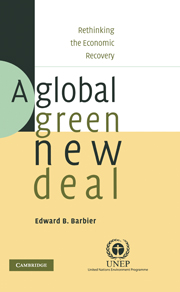Book contents
- Frontmatter
- Contents
- List of figures
- List of tables
- List of boxes
- Foreword
- Preface
- Acknowledgements
- Part I Why a Global Green New Deal?
- Part II The Key Components of a Global Green New Deal
- 2 Reducing carbon dependency
- 3 Reducing ecological scarcity
- 4 Challenges facing developing economies
- 5 National priorities for a Global Green New Deal
- Part III The Role of the International Community
- Part IV Towards a Greener World Economy
- Appendix 1 PIIE–WRI analysis of a green recovery program for the United States
- Appendix 2 Pew comparative analysis of clean energy jobs and investments in the United States, 1998–2007
- Glossary
- Index
- References
3 - Reducing ecological scarcity
Published online by Cambridge University Press: 05 June 2012
- Frontmatter
- Contents
- List of figures
- List of tables
- List of boxes
- Foreword
- Preface
- Acknowledgements
- Part I Why a Global Green New Deal?
- Part II The Key Components of a Global Green New Deal
- 2 Reducing carbon dependency
- 3 Reducing ecological scarcity
- 4 Challenges facing developing economies
- 5 National priorities for a Global Green New Deal
- Part III The Role of the International Community
- Part IV Towards a Greener World Economy
- Appendix 1 PIIE–WRI analysis of a green recovery program for the United States
- Appendix 2 Pew comparative analysis of clean energy jobs and investments in the United States, 1998–2007
- Glossary
- Index
- References
Summary
The previous chapter looked in detail at measures aimed towards creating low-carbon economies as part of an overall Global Green New Deal that can stimulate economic recovery and create employment over the next one to two years while putting the world on a more economically and environmentally sustainable development path. Such a strategy should be a priority for all countries – high-income OECD economies, large emerging market economies and low-income economies.
Although a low-carbon strategy is important to a GGND, this chapter addresses another critical area: the reduction of ecological scarcity, which is crucial to the aim of eliminating poverty worldwide. Such an objective is essential. A GGND cannot be truly global in scope unless it addresses all the pressing needs of the world economy. As emphasized in part I, the issue of extreme world poverty is an ongoing problem that needs to be urgently addressed.
Accordingly, a principal objective of a GGND is that it must also contribute to achieving the Millennium Development Goals for developing countries, so that by 2025 the goal of ending extreme global poverty is attainable. This chapter establishes the link between ecological scarcity and the livelihoods of the poor. It then outlines several ways in which national actions can improve these livelihoods while making progress towards reducing ecological damage, improving natural resource management and managing global water scarcity.
- Type
- Chapter
- Information
- A Global Green New DealRethinking the Economic Recovery, pp. 97 - 158Publisher: Cambridge University PressPrint publication year: 2010



